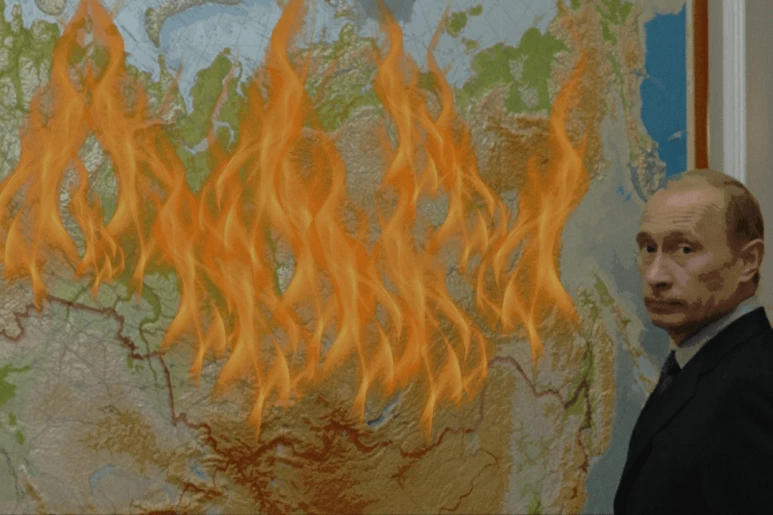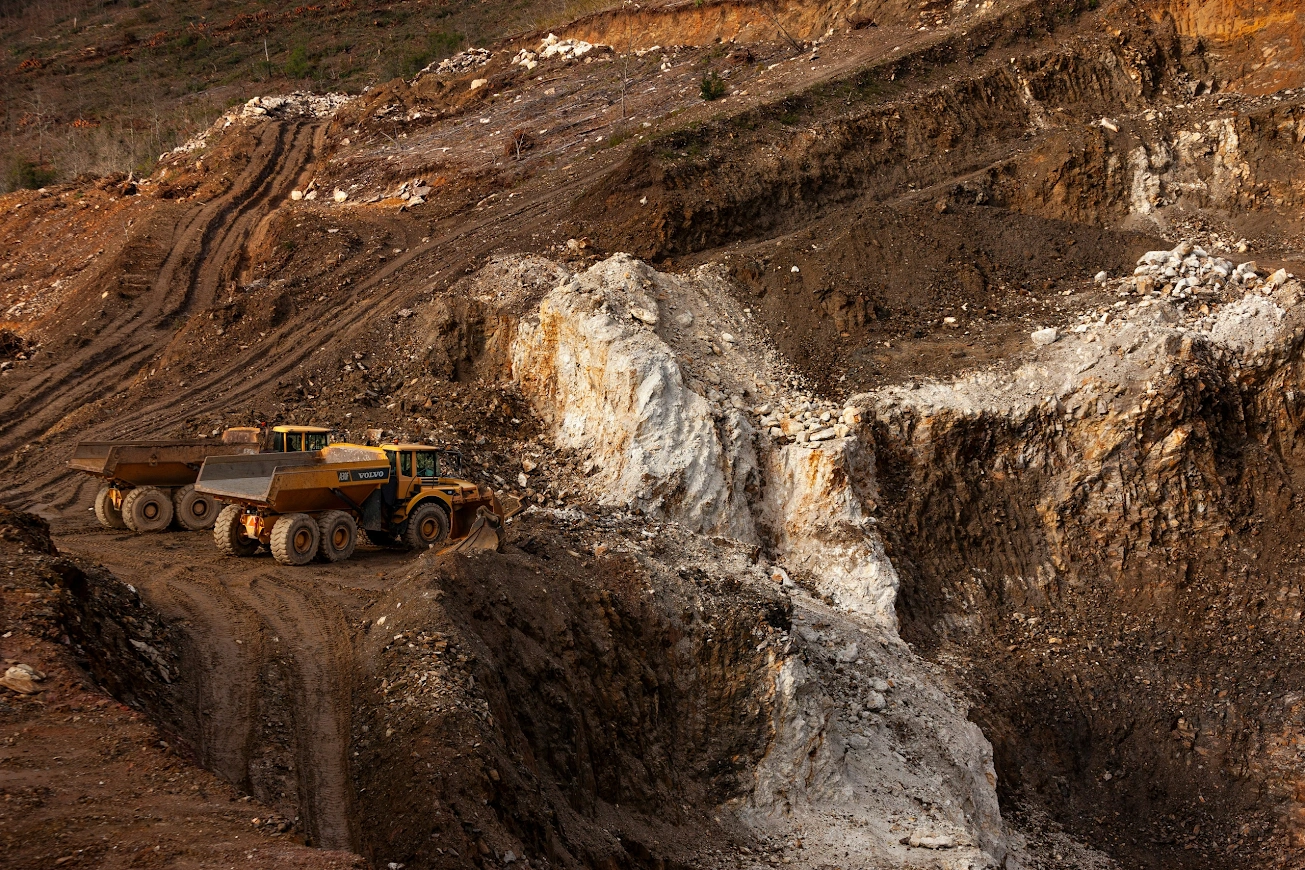Factories, storage facilities, and malls. During the first month of this hot summer, the number of fires in Russia has grown faster than ever. After analyzing the number of cases related to fires in Russia and the trend in the rate of fire spread, we can conclude that this June broke all previous records for the number of fires and explosions.
Molfar analysts gathered media reports and information on how many, where, and what burned the most in Russia.
You can read the report on the previous two quarters at this link.
Burning statistics: Russia burns three times more often
There were 288 fires in the previous three months in Russia. This may seem like a small number for Russia at first. But a closer look at the data shows that it is three times higher than in the same period last year: there were only 92 fires in 2022.
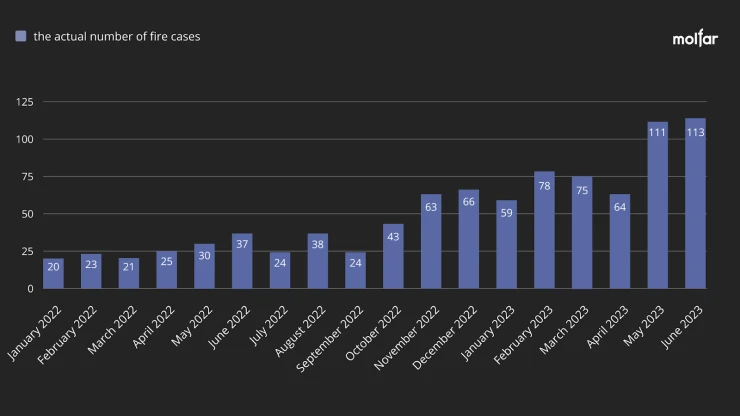
In 2022, there were a total of 414 fires. At the beginning of 2023, there were already more than 500. And that's just the first half of the year.
Let's look at this year's statistics on fires and fires in Russia. In January, 59 fires were recorded, and in February — 78. That is a 32% increase. March and April were relatively calm, with only 75 and 64 fires, respectively. But there was a literal explosion in May and June — 111 and 113 fires were recorded due to media reports. In other words, since the beginning of the year, the following trend has been observed: each month brings an average of 17% more fires in Russia.
On 12 December 2022, the Ukrainian charity foundation "Come Back Alive" reported completing fundraising for the "Black Box" project. Later, the Main Directorate of Intelligence of the Ministry of Defence of Ukraine said that Moscow had incurred $700 million in losses from the "Black Box" project.
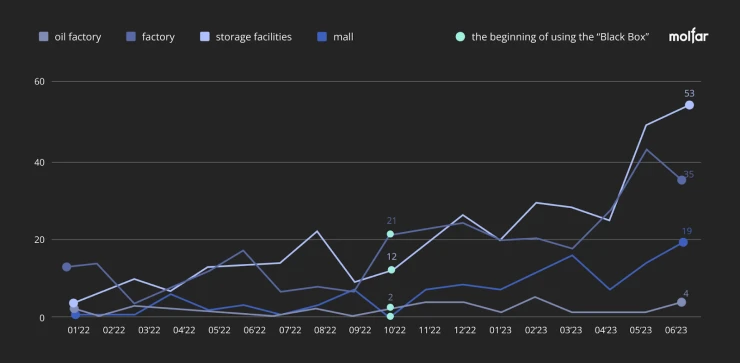
Here are the top 5 most significant fires in Russia over the past three months:
- Sverdlovsk region. The city of Revda. On 23 May, a garbage dump burst into flames—an area of 55 thousand square meters.
- Tomsk region. The village of Gubino. On 27 May, a woodworking company burned down—an area of 30 thousand square meters. The fire was extinguished for almost a day by 10 fire trucks and 40 people.
- Samara region. The city of Tolyatti. On 13 May, a paint factory caught fire there. The area of the fire was 20 thousand square meters. The fire was extinguished using 69 units of equipment with 314 people.
- Primorsky Krai. The town of Lesozavodsk. On 24 April, a woodworking factory burst into flames. The fire covered 12 thousand square meters.
- Kemerovo region. The city of Yaroslavl. On 20 June, a storage facility burned down. The fire destroyed 2.5k sq. m. It was reported that paint and varnish materials were stored there.
As we can see, May had the most enormous fire area – a total of 142,000 square meters burned. June, on the other hand, had the most extensive fire incidents. During the very first month of this summer, 113 Russian facilities burned down.
What is burning the most in Russia?
Russian storage facilities have been the most explosive since the beginning of this year. According to Molfar analysts, 20 Russian warehouses burned down in January at the beginning of the year. In June – 53. Factories also often burn down. In February, the fire destroyed 20 production facilities. In June - 35.
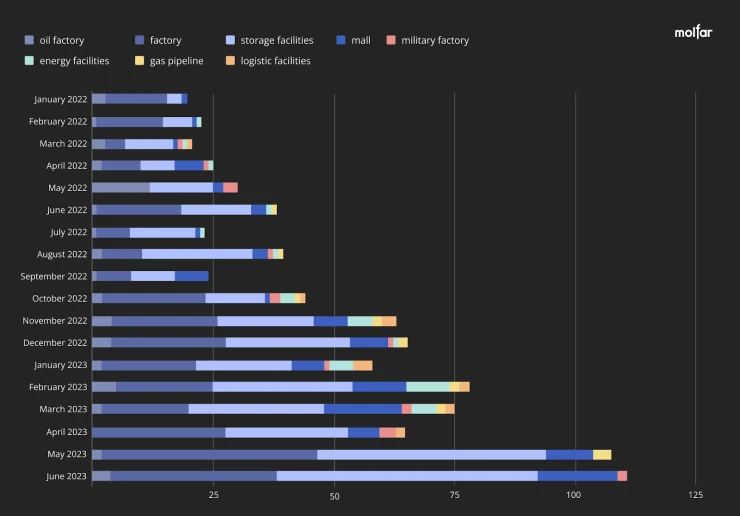
The official report of the Russian Emergencies Ministry for 2022 noted the most frequently burning facilities. Production facilities occupy the first place. The number of fires there increased by 22.9% compared to 2021:
— storage facilities (up 22%);
— shops (up 16.3%);
— offices (an impressive 99% rise).
There is some data on military facility fires. There were 72 fires at military locations across Russia in 2022. 44 of them were arsons at recruitment centers. An additional 28 fires were recorded in military units, ammunition depots, and military airfields. It is likely that this year these trends will not only continue but will also exceed all expectations, given this trend.
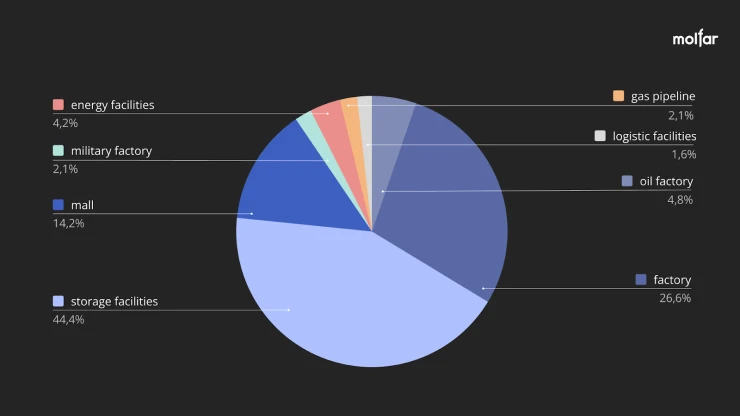
A breakdown of fires by type of facility shows that different infrastructure sectors are at risk. We can also see that Russian storage facilities are particularly fire-prone. Their percentage is the highest in this statistic (44.4%), and this trend has continued since the beginning of the year. Looking at the data from a different angle, we see that in May 2023, the total number of fires at factories alone exceeded that of all objects recorded in May 2022.
An interview from December 2022 with Vladimir Zhemchugov, a former commander of a Donbas guerrilla cell, suggested that the "Svoboda Rossii" and "Atesh" legions might have been involved in the arson attacks on Russian shopping malls and storage facilities, as well as the possible role of Ukrainian diversionary groups in attacks on Russian military facilities.
The Moscow Region is the leader in the number of fires in Russia. Again
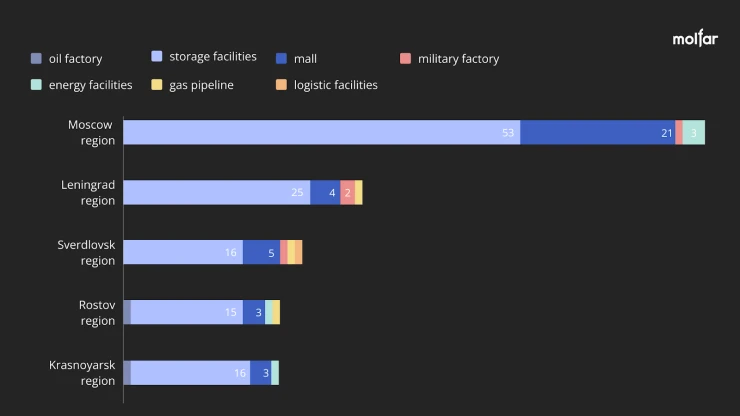
As in previous Molfar analyses, the Moscow region is the most explosive. Over these three months, the Leningrad, and Sverdlovsk regions have also become centers of Russian fires. These fires are likely to have caused severe material damage, as they usually cover a large area. Several administrative buildings, military enlistment offices, and a military headquarters were on fire.
So let's take a closer look at some of those.
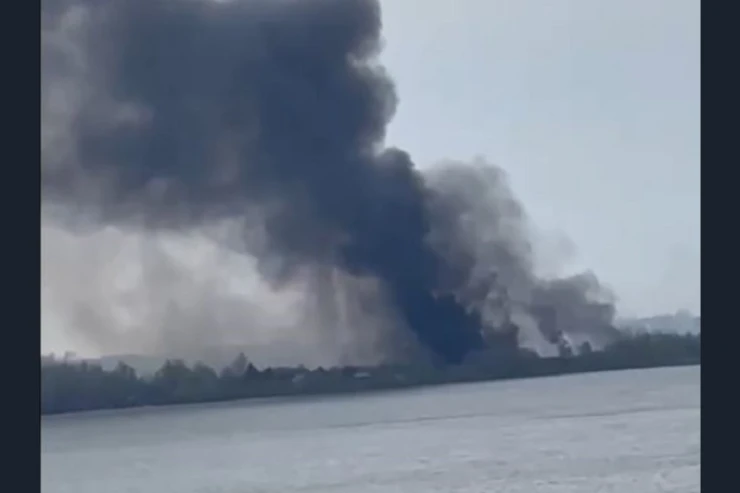
- This is one of the most significant fires of the month. An entire island burned down in the Tomsk region. It burned 100,000 square meters of dead grass. At the same time, there were 34 buildings destroyed on the island. Firefighters were brought to extinguish the fire by boat. Curiously, according to the same report, no official buildings exist on the island.
- Another fire in St. Petersburg occurred on 17 April at the Magneton plant at 9 Kurchatova St. This plant produces magnetic materials and components, particularly for the automotive and medical industries. Witnesses reported that they heard a 'popping' sound.
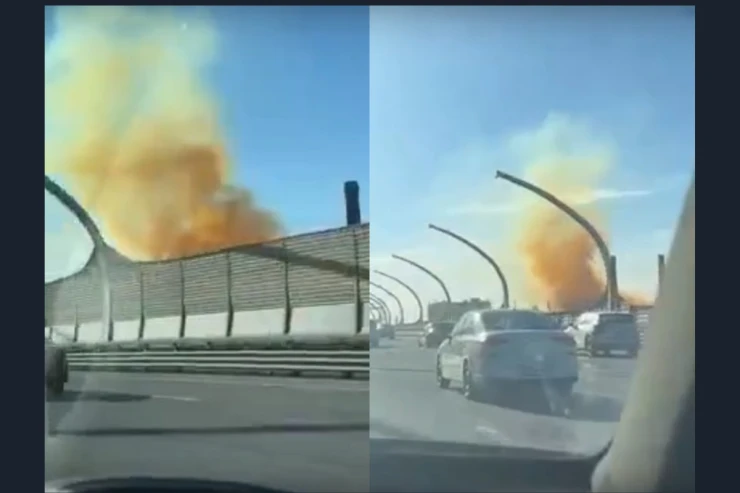
- We had another adventure in St Petersburg in two days—this time at the Kirov Plant. The plant produces a variety of heavy equipment, including metallurgical, power generation, and mechanical engineering equipment. Following the fire, a column of dirty red smoke billowed over the plant. It could have been poisonous gas, but later an official "explanation" was issued by the plant's management. According to them, it was a "fox tail". It rose above the plant due to "technological processes" and did not violate Russian sanitary standards.
- On 18 June, the Russian military's division headquarters was on fire. It took place near Yekaterinburg. It started in the division commander's office on the building's second floor. At the time, all staff members had a day of rest.
- Finally, the fire at the Center for Hygiene and Epidemiology in Voronezh, Russia, is worth mentioning. Visitors and employees were evacuated from the premises.
As we can see, fire drama in Russia is growing. Even Russia's largest and most "modern" businesses are burning down. Regarding the number of fires, June was the hottest, and May was notable for the scale of the fire.
Short reports in the Russian media clarify that the country's leadership and various enterprises are increasingly trying to conceal the actual scale of the tragedies. Moreover, the security situation at Russian enterprises is poor. As a result, logistics facilities, oil refineries, storage facilities, and factories are currently the most vulnerable.

